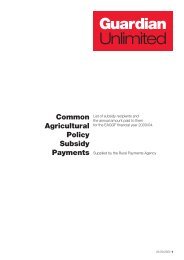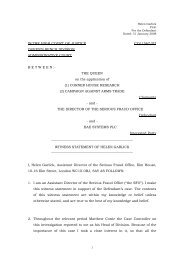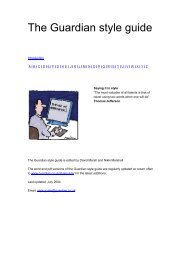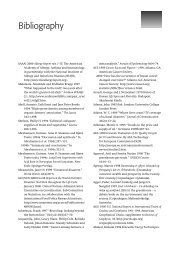KATINE COMMUNITY PARTNERSHIPS PROJECT - Guardian.co.uk
KATINE COMMUNITY PARTNERSHIPS PROJECT - Guardian.co.uk
KATINE COMMUNITY PARTNERSHIPS PROJECT - Guardian.co.uk
You also want an ePaper? Increase the reach of your titles
YUMPU automatically turns print PDFs into web optimized ePapers that Google loves.
were designed to reinforce existing structures above them, especially at<br />
implementation level.<br />
� Project governance structures, including the Project Management Committee (at sub<strong>co</strong>unty<br />
level) and the Project Steering Committee (at district level) were formed to<br />
manage and support project implementation and sustainability. This will be achieved<br />
through closer links and between the <strong>co</strong>mmunity groups and local government<br />
structures in responding to developmental priorities.<br />
� IEC is one of the main KCPP strategies for creating awareness about <strong>co</strong>mmunity<br />
rights to basic services like health, education and water. They reinforce sensitisation<br />
and education of <strong>co</strong>mmunities during <strong>co</strong>mmunity meetings, trainings and outreaches.<br />
Development of IEC awareness messages for radio programmes, posters and leaflets<br />
were carried out in order to increase the <strong>co</strong>mmunity’s knowledge of health, education,<br />
water and sanitation. Other key IEC messages were developed together with sub<strong>co</strong>unty<br />
and district local government partners. Although the VHTs also play a key role<br />
in bringing key health messages to the <strong>co</strong>mmunity.<br />
� A district stake-holder’s meeting was <strong>co</strong>nducted to update local government and NGO<br />
partners about the project. During this meeting, a working relationship with the<br />
partners was discussed and agreed upon. The stakeholders’ meeting was held on<br />
April 3 rd , 2008 at Soroti Hotel and was attended by a total of 66 participants (15<br />
women and 51 men). The attendants included district partners, sub-<strong>co</strong>unty<br />
representatives, district political representatives, NGOs, representatives from AMREF<br />
UK, AMREF Headquarters, AMREF Country Office and KCCP project staff. During the<br />
meeting, some of issues raised included AMREF’s <strong>co</strong>ntinued support of the Traditional<br />
Birth Attendants (TBAs) despite government policy to phase them out. Another issue<br />
was the absence of se<strong>co</strong>ndary school interventions in the KCPP when Katine has only<br />
one that needed assistance. There was also <strong>co</strong>ncern surrounding a lack of indicators<br />
for the <strong>co</strong>mmunity empowerment <strong>co</strong>mponent. Also, some members wanted<br />
clarification on the criteria for selecting borehole drill sites. For livelihood activities,<br />
members were <strong>co</strong>ncerned as to why the project chose cassava and groundnuts as<br />
priority crops when these are locally available in Katine. In addition, members<br />
identified a gap in the baseline survey since it lacked information on HIV/AIDS for<br />
youth and children. Another issue raised was the delay in launching the project as well<br />
as the short (3-year) project lifespan.<br />
� The above issues which were clarified by the project implementation team will be kept<br />
in mind and where possible addressed during the <strong>co</strong>urse of project implementation. In<br />
addition, a stakeholder inventory was developed and is being used for <strong>co</strong>ordination<br />
and mobilisation to strengthen networking.<br />
4.2 Disparities in performance, why and how they will be addressed<br />
Improved <strong>co</strong>mmunity health<br />
The VHT structure was set up more than three years ago but has not yet proven to be stable<br />
and effective. There are challenges associated with the members selected by the <strong>co</strong>mmunity<br />
because some of them cannot read and write in their local languages. The VHTs will therefore<br />
be allocated roles ac<strong>co</strong>rding to their level of <strong>co</strong>mpetency by the district health teams. For<br />
instance, those who cannot read or write are allocated mobilisation roles such as <strong>co</strong>nducting<br />
KCPP six monthly narrative report - October 2007 to March 2008 20












